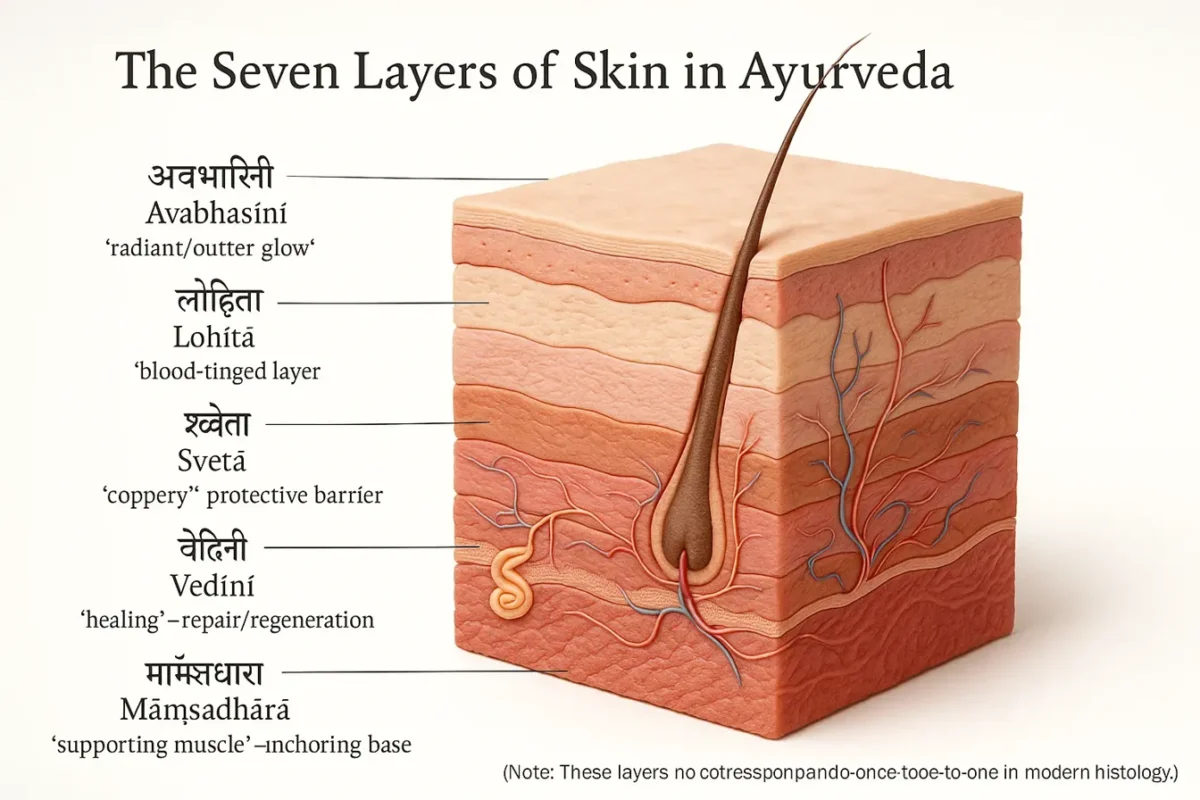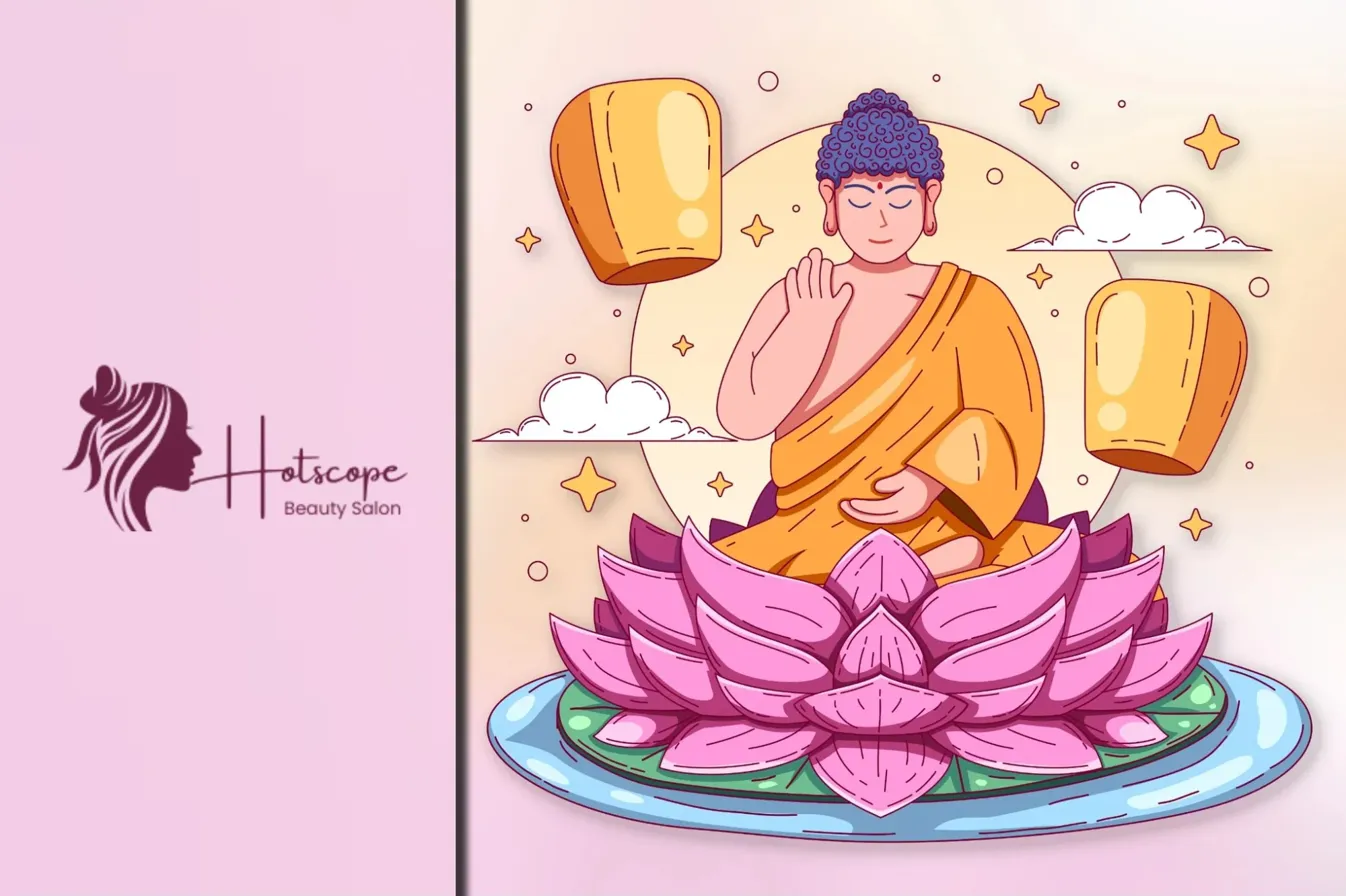In Ayurveda, skin is referred to as Twacha(Twak). It is not merely an external covering but a significant organ that reflects the internal state of the body.
Development of Skin
The development of Twak occurs from the transformation of Rakta (blood) into Mansa (muscle) during embryonic growth. According to Ayurveda, Twak develops like how cream forms from milk, illustrating its nuanced development process through structured layers. This epidermal structure is completed by the sixth month of fetal life, consisting of seven distinct layers.
Twak is characterized by its Sneha Sara (oiliness) quality, highlighting its nourishment from Rasa Dhatu (plasma). This underscores the vital roles of both external applications and dietary considerations in maintaining skin health.
Ayurvedic Perspective on Skin Health – The Seven Layers of Skin in Ayurveda

Your skin isn’t just one layer – Ayurveda identifies seven distinct layers, each with specific functions. The first layer, Avabhasini, reflects complexion and glow. The second, Lohita, supports blood vessels. Problems at different layers show up differently – surface acne versus deep cystic issues come from different layer imbalances. Understanding this helps explain why some treatments work superficially while others need deeper intervention.
According to Ayurveda, the health of the skin relies on the nutrients provided by the Rasa Dhatu (nutrient fluid, the first of the seven tissues of the body). This nutrient fluid is generated from the diet we eat, which is largely influenced by how we digest food. Therefore, our Agni (digestive fire) must be optimal—the beauty of the skin depends on our diet as well as the health of our digestive system.
Hence, what we eat and what we digest determines our skin’s health.
Skin Types Based on Other Sanskrit Theories

Skin Types Based on Prakriti
The color, texture, thickness, and glow of skin differ from person to person since body constitution (Prakriti) varies individually. Therefore, approaches to skincare depend on the Prakriti of an individual.
- Vata Prakriti – Dry, uneven-toned, rough, prone to fine lines and wrinkles. Thin texture with fine pores, cracked, and cool.
- Pitta Prakriti – Sensitive, soft, warm, and moist. Prone to tanning, acne, moles, and inflammation. Medium thickness.
- Kapha Prakriti – Thick, oily, pale, soft, glossy, and cool. Prone to enlarged pores, cystic acne, and dull complexion.
What Is Ayurvedic Skin Care?
The quality of the skin depends on Prakriti. To maintain and restore healthy skin, the Prakriti needs to be balanced. The key to healthy skin is to follow a diet and regimen that matches one’s body type (Deha Prakriti).
Timing Your Skincare – The Ayurvedic Clock
Your skin follows a biological clock. Morning (6-10am) is Kapha time – skin is naturally plumper but prone to oiliness. Midday (10am-2pm) is Pitta time when skin is most sensitive to sun damage. Evening (6-10pm) is Kapha again, perfect for nourishing treatments. Night (10pm-2am) is crucial Pitta time for skin repair and cellular regeneration.
This explains why heavy creams work at night but cause breakouts in morning Kapha time. It’s why vitamin C serums work best in morning defense mode, while retinoids excel during nighttime repair.
Daily Skin Care Routine
Ayurveda recommends bathing twice a day and washing the face three to four times daily with warm water. Since the skin acts as an excretory organ, if metabolic waste is not removed, it accumulates on the surface and causes skin problems.
Ayurveda prescribes Udvartan (scraping therapy), which prevents excessive deposition of Meda and Kapha dosha, removes impurities, improves circulation, and nourishes the skin.
Face Packs for Oily Skin
- Masoor dal soaked overnight, ground with milk or almond oil
- Multani mitti with sandalwood powder and rose water
- Fresh rice paste
- Lemon juice application
- Dried orange peel paste with curd
- Apple, cucumber, or tomato slices
Face Packs for Dry Skin
- Almond oil with multani mitti
- Rice, fenugreek seeds, and besan with coconut oil
- Fresh milk application
- Neem paste with butter
- Yashtimadhu, turmeric, rose water, and almond oil
- Manjistha, turmeric, tulsi, and brahmi paste
- Amla powder with aloe vera juice
- Masoor dal, ashwagandha, skimmed milk, and ghee paste
Ayurvedic Approach to Glowing Skin
Rasa Dhatu nourishes Twak. Deficiency in Rasa can lead to dryness, showing the direct link between internal health and skin condition. Ayurveda emphasizes right nutrition, adequate sleep, a healthy state of mind, and dosha balance.
Rasayana herbs nourish Rasa Dhatu and Rakta Dhatu, preventing dullness, spots, and pigmentation.
Ayurvedic Herbs for Skin Glow
Many herbs are mentioned in Ayurveda for skin radiance, including:
- Shwetchand
- Madhuyashti
- Manjistha
- Nagkesar
- Padmak
- Sariva
- Ushir
- Lodhra
- Kesar
- Haridra
- Daruharidra
- Neem
- Amalaki
Choosing the Best Ayurvedic Skincare Products
- Certifications – Look for authentic Ayurvedic and organic certifications.
- Ingredients – Neem, tulsi, sandalwood, kumkumadi.
- Formulas – Oil-based formulas are superior to creams as oil penetrates deeper, carrying herbal potency to nourish and rejuvenate the skin.
The 21-Day Skin Reset Protocol
- Week 1 – Internal Cleansing: Start with warm water and lemon each morning. Eat kitchari (mung dal and rice) for lunch. Take triphala at night. This gentle detox removes accumulated ama.
- Week 2 – Building Practices: Add abhyanga with appropriate oil. Include skin-supporting foods like cooked leafy greens, sweet juicy fruits, and whole grains. Practice 5 minutes of deep breathing before bed.
- Week 3 – Targeted Treatments: Introduce specific herbs for your skin type. Add weekly face masks. Include ghee in morning routine for internal moisturizing.
Other Routines for Glowing Skin
- Diet – Follow a vegetarian diet. Avoid fatty, fried, processed foods, excess salt, sugar, seafood, and red meat (Viruddha Ahara).
- Sleep and Exercise – Exercise promotes sweating, circulation, and mental calmness. Adequate sleep stimulates growth hormones that promote collagen and elastin production, keeping skin taut.
- Yoga – Improves blood and lymph circulation, tones muscles, and enhances Ojas, vitality, and glow.
Can You Follow an Ayurvedic Routine at Home?
Yes. Ayurveda emphasizes Dinacharya (daily routine) and Ritucharya (seasonal routine). Practices such as Abhyanga (oil massage), Mukhalepa (herbal face packs), Udvartana (powder massage), proper diet, and Pranayama can be done at home. Panchakarma therapy is recommended seasonally for detoxification.
Dosha Imbalance and Skin Problems
- Pitta imbalance – Pigmentation, redness, acne, melasma.
- Vata imbalance – Dryness, rough patches, premature wrinkles.
- Kapha imbalance – Oiliness, clogged pores, dullness.
Pigmentation (Vyanga) is often due to Pitta and Rakta Dushti (blood vitiation).
Can Ayurveda Lighten Pigmentation or Dark Spots?
Yes. Ayurveda offers both internal detoxification (Panchakarma, Rakta-shodhana, Rasayana) and external applications.
- Panchakarma therapies – Virechana (purgation), Nasya (nasal therapy), Raktamokshana (bloodletting).
- Herbal pastes – Manjistha, lodhra, yashtimadhu, sandalwood, nutmeg.
- Formulations – Kumkumadi oil, Varnya dravyas for complexion.
Avoid Harsh Synthetics, Embrace Nature
Harsh chemicals in skincare can cause irritation, rashes, allergic reactions, and long-term sensitivity. Some, like parabens and phthalates, may also disrupt hormones and increase health risks.
Opting for natural, fragrance-free, and sulfate-free products is a safer way to protect skin and overall health.

